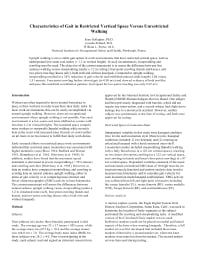Mining Publication: Characteristics of Gait in Restricted Vertical Space Versus Unrestricted Walking
Original creation date: September 2010
Authors: S Gallagher, JP Pollard, WL Porter
NIOSHTIC2 Number: 20037784
Proceedings of the Human Factors and Ergonomics Society 54th Annual Meeting, September 27-October 1, 2010, San Francisco, California. Santa Monica, CA: Human Factors and Ergonomics Society, 2010 Sep; 54:1149-1153
Upright walking is not a viable gait option in work environments that have restricted vertical space, such as underground low-seam coal mines (< 1.2 m vertical height). In such circumstances, stoopwalking and crawling must be used. The objective of the current manuscript is to assess the difference between free cadence walking versus stoopwalking (under a 1.2 m ceiling), four-point crawling (hands and knees), and two-point crawling (knees only), both with and without kneepads. Compared to upright walking, stoopwalking resulted in a 24% reduction in gait velocity and exhibited reduced stride length (1.04 versus 1.51 meters). Four-point crawling further slowed gait (to 0.50 m/s) and showed evidence of both trot-like and pace-like interlimb coordination patterns. Gait speed for two-point crawling was only 0.32 m/s.

NIOSHTIC2 Number: 20037784
Proceedings of the Human Factors and Ergonomics Society 54th Annual Meeting, September 27-October 1, 2010, San Francisco, California. Santa Monica, CA: Human Factors and Ergonomics Society, 2010 Sep; 54:1149-1153
- The Effects of Restricted Workspace on Lumbar Spine Loading
- Keeping Knees Healthy in Restricted Work Spaces: Applications in Low-Seam Mining
- Lifting in Stooped and Kneeling Postures: Effects on Lifting Capacity, Metabolic Cost, and Electromyography of Eight Trunk Muscles
- Locomotion in Restricted space: Kinematic and Electromyographic Analysis of Stoopwalking and Crawling
- Pressure Distribution on the Anatomic Landmarks of the Knee and the Effect of Kneepads
- Random Motion Capture Model for Studying Events Between a Machine and its Operator
- Refuge Alternatives in Underground Coal Mines
- Remote Methane Sensors
- Wireless Mesh Mine Communication System
- Working in Unusual or Restricted Postures